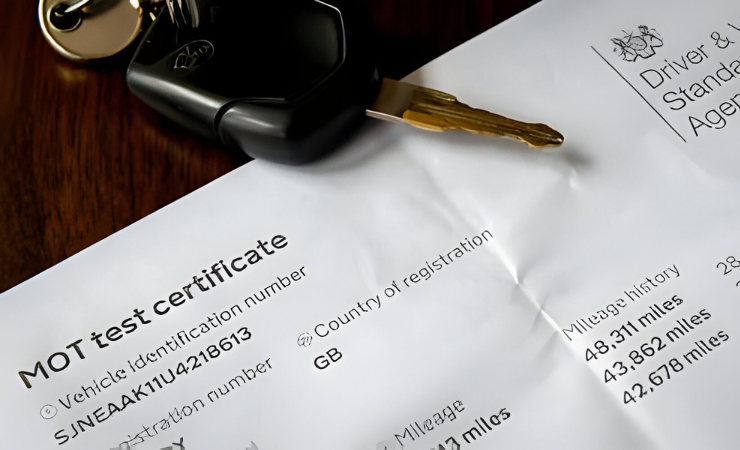The MOT test is an annual examination of a vehicle’s safety, roadworthiness, and exhaust emissions. Passing the MOT is legally required to drive on UK roads, making the test results vitally important. This article covers interpreting your MOT outcomes and the necessary post-MOT actions.
Understanding Your MOT Test Results
There are three potential MOT test outcomes:
- Pass: The vehicle meets the minimum legal standards for driving on roads.
- Pass with advisories: Minor defects were found, but they are still legally roadworthy.
- Fail: Dangerous faults or major defects identified that make the vehicle illegal to drive without repairs.
The MOT certificate details any vehicle inspection results, including:
- Odometer reading
- General condition and corrosion levels
- The functionality of lights, horns, mirrors, etc.
- Brake performance and component condition
- Steering and suspension condition
- Exhaust system condition
Passing the MOT
A “clean pass” MOT means no advisories or defects found. This indicates your car is in good working order and considered fully roadworthy and safe to drive.
After passing, you can legally drive for another year before the next MOT is due. Still, arrange the next test a month before to allow time for unanticipated repairs.

Passing with Advisories
Advisories indicate minor defects found that should be monitored or fixed soon but don’t currently make the car illegal or dangerous to drive.
There are two levels of advisories:
- Minor: Cosmetic issues or items needing eventual replacement.
- Major: More significant problems that, while still legal, need attention to prevent MOT failure next time.
To address advisories, prioritize major issues first. Seek cost estimates from mechanics for more significant repairs. Minor advisories can wait or potentially be DIY fixes.
Failing the MOT
Failing an MOT means dangerous faults or major defects were found making the vehicle illegal to drive without fixes. Failure reasons fall into two categories:
- Major defects: Significant mechanical or structural issues making the car unroadworthy.
- Dangerous defects: Safety-related faults causing an immediate driving prohibition.
Until fixed and retested, cars with a failed MOT can only be driven to a garage for repairs in limited circumstances.
Post-MOT Actions & Next Steps
Carefully review your Vehicle Inspection Report for full details on any advisories or failure reasons found. Get repair estimates from mechanics outlining costs to address them.
For MOT failures, promptly schedule necessary repairs so the car can be made legal to drive again and retested. Prioritize serious issues first. Retests cost fees and have time limits.
For a comprehensive guide on the MOT booking process itself, read our article: Guide to Booking and Taking Your Vehicle for an MOT.
Addressing MOT Advisories & Minor Defects
With advisories, decide which to fix first based on severity, costs, and personal timeframe. Minor cosmetic issues can wait, while more mechanical defects should be addressed sooner.
Consider DIY repairs if feasible, or use a professional mechanic for complex issues like brake, steering or suspension components. If repairs are performed within 10 working days, partial MOT retests are possible to assess just the fixed items.
Handling MOT Failures & Major Defects
Legally, cars with failed MOTs cannot be used on public roads, except when driving to a garage for repairs or a home after getting the news. Continuing to drive a car with dangerous defects risks fines, penalty points, or invalidated insurance.
If you genuinely believe the MOT failure was unjustified, you can appeal the decision and request a second inspection. However, this still means making any identified repairs first before the vehicle can be fully retested and deemed roadworthy to have the MOT certificate renewed.
Comprehensive repairs should be done promptly to fix all major and dangerous defects. This includes replacement parts, mechanics’ labor, calibration, testing, and certification to confirm the car is now fully safe and road-legal.
Dangerous Defects & Serious MOT Failures
Cars with failures due to immediate prohibitive dangerous defects cannot be driven at all until fixed, except for loading onto a trailer or truck to go directly to a garage. Towing expenses may also be required.
Such critical failures put not only the driver but other road users at serious risk and must be addressed before the car takes another trip. Expect extensive repairs and costs to make the vehicle roadworthy and legal again.
After Repairs & Retests
Once repairs are complete, contact the MOT test center to arrange a retest appointment. Partial retests focus only on fixed items, while full retests assess the whole car again. Retest fees apply and vary based on the test extent.
If the retest is passed, a new MOT certificate will be issued, renewing the car’s roadworthiness status for another year. Continue monitoring and servicing the vehicle to keep it in safe driving condition until the next annual MOT.
MOT results dictate the next steps you must take, whether routine maintenance after a pass or urgent repairs following failure. Addressing advisories and defects promptly is vital for staying legal and safe and avoiding problems at your next test. Maintain your car between MOTs, too.
